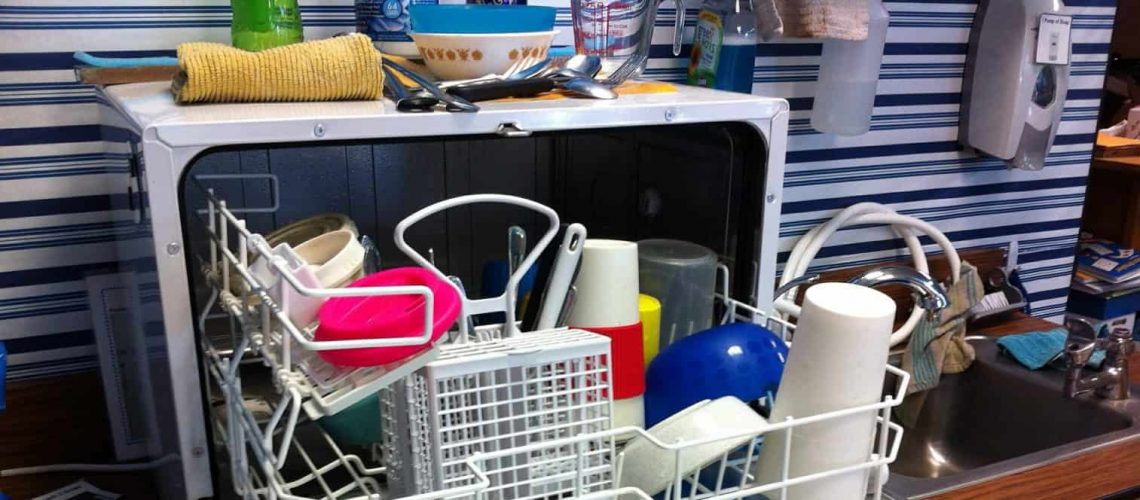- More Baby & Kid
- More Cars
- More Electronics
- More Health & Fitness
- More Hobby & Crafts
- More Home & Garden
- More Other
- More Outdoor
- More Pets
SolidGuides.com may get an affiliate commission when you buy through links on our website. Read More.

Cleaning your dishwasher may seem counter-intuitive at first. After all, we expect them to wash everything we put inside, right? However, dishwashers need some maintenance from time to time to keep them running as intended.
In case you’re looking to change your old dishwasher for a new one or just looking for your first one, be sure to choose the right dishwasher.
If you’re not sure whether you need to roll up your sleeves and use some elbow grease, here are some signs and symptoms that tell you it’s time to clean your dishwasher:
For this job you’ll need a few simple household items:
Following these straightforward steps, you can be sure to have your dishwasher running as good as new in no time.
Step one: Empty your dishwasher.
It’s best to clean your dishwasher after a cycle has been completed, so make sure you’ve emptied all the dishes and utensils first. Secondly, take out any removable racks and utensil holders. Lastly, remove the filter and accompanying parts – sometimes small particles accumulate here and begin to smell during the drying cycle. If the last step looks complicated, make sure to snap photos along the way, so you know how to put it back together later.
Step two: Check the spray discs or arms.
If your dishwasher isn’t spraying water, deposits may be clogging the holes in the spray arms or discs. Use a toothpick or wooden barbecue skewer to remove caked-on food. Keep in mind that not all dishwasher are built the same; You might have more than one spinning arm, so check all the holes.
Step three: Wash the removed parts.
Using a soapy sponge and old toothbrush for those hard-to-reach places, wash all the racks, utensil holders and filter parts. If there’s lots of gunk and hard-to-remove residue, you can soak everything in warm water for 15-20 minutes by filling your sink halfway and adding a cup of vinegar.
Step four: Clean the insides.
Using a 1:1 solution of water to vinegar, along with a cloth and sponge, clean the inside of your dishwasher. This includes the bottom of the door, door seal, the sides and the bottom. You can use an old toothbrush, the corner of your rag, or q-tips to reach small crevices and tight spots. Also, don’t forget to clean the door edges.
Step five: Put it all back together.
Once you’ve cleaned everything and given the inside of your dishwater a once over, put all the parts back in their place.
Step six: Start a cycle with vinegar.
With the dishwasher empty, take a cup of white vinegar and place it on a rack. Then pick the highest temperature setting and run a full cycle. As the washer runs through a program, water will push the vinegar out slowly and dispense it throughout the dishwasher. This step will get rid of any smelly dishwasher odors and also work wonders for plaque or calcium build-up.
Final step: Clean the outside of your dishwasher.
For this step, you can use washing-up liquid, the 1:1 vinegar solution, or a specialized cleaning product of your choice. Apply what best suits your situation, wipe down with a wet cloth, rinse, and finish off with a dry microfiber cloth to remove streaks.
If you’re not thrilled at the thought of thoroughly cleaning and scrubbing your dishwasher, here are a few routine maintenance tips that will help keep it working best as it can and keep it cleaner for longer:
Don’t forget to use your dishwasher.
If you’re not using your dishwasher regularly, debris and particles can build-up and dry out making them even harder to remove or making them smell. If nothing else, run your dishwasher empty once a week with a hot setting, especially if you use the eco/water-saving cycle that tends to run cooler.
Scrape off larger pieces of food.
You don’t have to rinse your dishes and pans as this might trick your dishwasher’s sensors that your plates are cleaner than they are, but scraping chunkier bits of food means you won’t have to remove them from the filter afterward.
Leave the dishwasher door slightly open.
You know what mold really likes? A hot and moist environment. To prevent a build-up of nasty microbes and funky smells, leave the door ajar after the cycle is done. This can also help with the drying process.
Clean the seals.
The food from your plate can end up stuck to the seals and make them deteriorate faster. However, cleaning them is quick and easy. All you have to do is use a damp sponge or cloth around the seals once a week or every other week.
Clean your dishwasher filter.
Once a week or twice a month, check your filter for build-up. It’s not the most pleasant of jobs, we know, but not cleaning your filter can lead to more severe problems. Wash it with hot running water, some dish soap, and an old toothbrush.
Don’t forget to add rinse aid and dishwasher salt.
Many dishwashers have an indicator for the rinse aid, but if yours doesn’t, you can check the levels manually. And while you’re at it, see if the salt well is empty or not. Rinse aid helps prevent streaking during the drying process, and dishwasher salts stop mineral build-ups. This check can be done once a month.